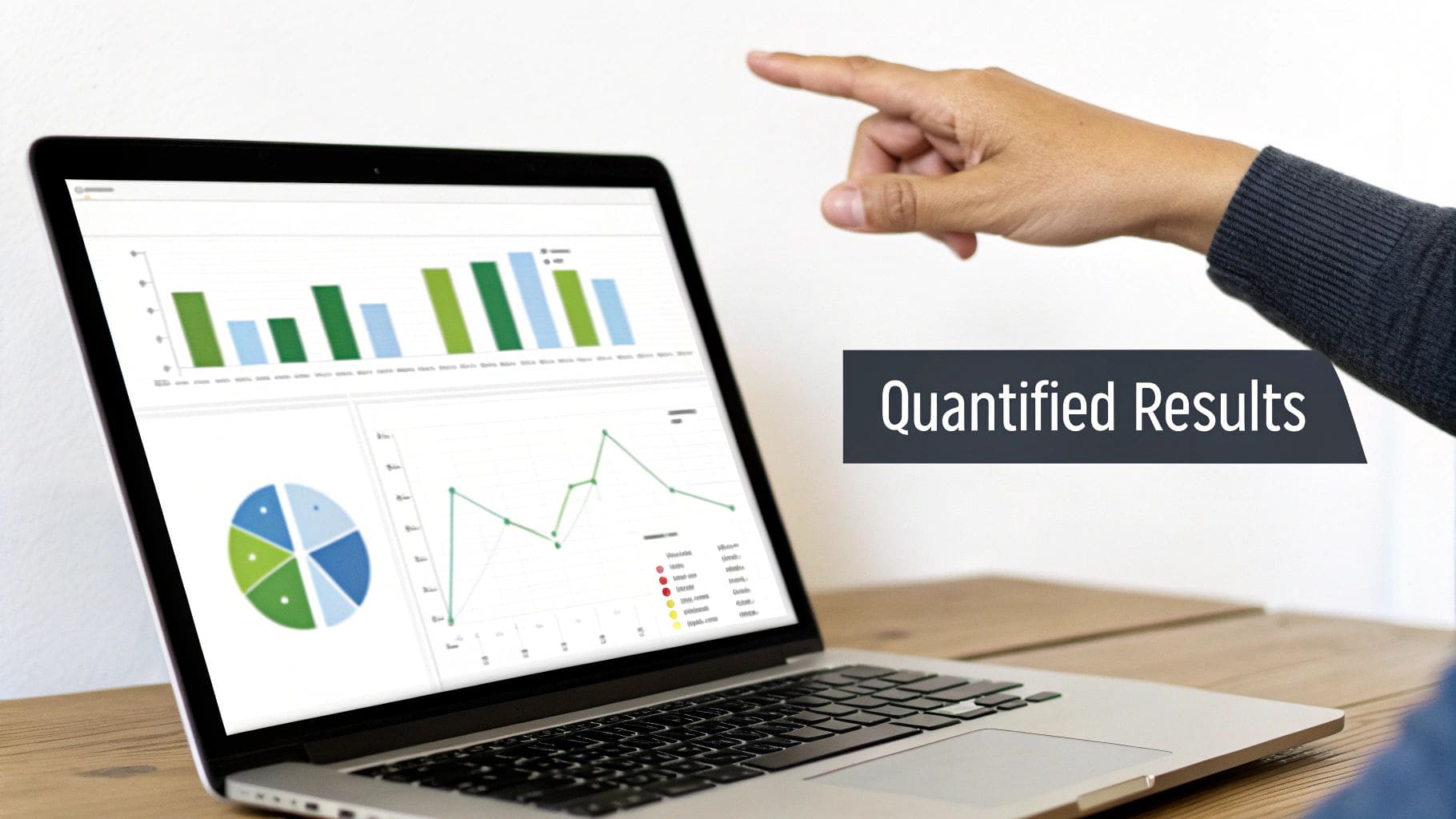How to Build a Standout Resume for a Data Analyst
Build a resume for a data analyst that gets results. This guide shares proven strategies for highlighting skills and projects to land more interviews.

How to Build a Standout Resume for a Data Analyst
To create a resume for a data analyst that gets noticed, you need an opening that immediately proves your value. The professional summary is your thirty-second pitch to grab a recruiter's attention by showcasing your blend of technical skill and real-world business impact. Forget generic statements; this is about framing your worth with cold, hard numbers. It's your chance to immediately answer the recruiter's biggest question: "Why should I bother reading the rest of this?"
Crafting an Impactful Professional Summary

The summary is the first thing a hiring manager will read, making it the most valuable real estate on your entire CV. It needs to be a tight, three-to-four-sentence paragraph that highlights your most impressive wins and core competencies right from the start.
This isn't the place for vague objectives or buzzwords. You need to lead with your experience level, mention key technical skills, and cap it off with a major achievement tied directly to a business outcome.
The Anatomy of a Powerful Summary
While every summary should be personalised, following a proven structure ensures you hit all the critical points. It's a simple formula that combines who you are professionally with what you can actually deliver.
A winning structure almost always includes these four elements:
Your Title and Experience: Kick things off with your professional identity, like "Data Analyst with 5+ years of experience".
Key Technical Skills: Weave in 2-3 high-demand tools from the job description, such as SQL, Python, and Tableau.
Quantifiable Achievement: This is the most important part. Include a powerful, metric-driven result. For instance, "...drove a 15% increase in marketing campaign efficiency".
Business Context: Briefly mention the industry you've worked in or the types of problems you solve. This shows you have commercial awareness.
Following this method turns a generic intro into a compelling snapshot of your capabilities. It's the difference between just saying you're skilled and actually proving it with evidence.
From Vague to Valuable Examples
Let's look at the difference between a summary that gets ignored and one that gets a call back.
Weak Example:
"Detail-oriented data analyst with experience in data interpretation and reporting. Seeking to apply my skills in a challenging new role."
This tells the reader absolutely nothing specific. It's forgettable. Now, let's inject our formula with quantifiable results and relevant keywords.
Strong Example:
"Data Analyst with 4+ years of experience leveraging SQL and Power BI to translate complex datasets into actionable business strategies for the retail sector. Proven ability to develop interactive dashboards that reduced reporting time by 25%. Passionate about uncovering insights that drive revenue growth and operational improvements."
Key Takeaway: The goal of your summary is to connect your technical abilities directly to business impact. Always quantify your achievements with numbers, percentages, or monetary values to make your contributions tangible and impressive.
This specific, results-oriented approach makes your resume far more compelling. If you need more inspiration for crafting a summary that stands out, you can explore a variety of powerful resume summary examples that cover different industries and experience levels. It's the best way to make sure your CV starts with maximum impact.
Get your free CV review
Upload your CV and get instant AI suggestions to improve your chances
Showcasing Your Technical and Analytical Skills

Your skills section is the first place a hiring manager's eyes will jump to. It's the technical handshake of your resume, and it has to deliver a quick, clear message: "I have the tools for the job."
This section needs to be instantly scannable, satisfying both human recruiters and the Applicant Tracking Systems (ATS) that act as the first line of defence. Just listing every technology you've ever touched isn't enough. That's a missed opportunity. Your goal is to present a structured, compelling inventory of your capabilities that shows you mean business.
A messy brain dump of skills only creates confusion. Instead, think like an analyst. The simple act of organising your skills into logical categories makes your expertise far easier to digest and, just as importantly, shows you have a structured, analytical mind.
Organising Skills for Maximum Impact
Think of your skills section as a mini-dashboard of your technical arsenal. Grouping your skills helps a hiring manager quickly tick the boxes for their essential criteria. A proven and effective structure is to break them down by their function in the data lifecycle.
Here are a few categories that work well:
Programming & Databases: This is your foundation. List core languages like Python (and add depth by mentioning libraries like Pandas or NumPy) and R. This is also the home for SQL—you can even specify dialects like T-SQL or PostgreSQL if they're relevant to the job.
Visualisation & BI Tools: Group your dashboarding and reporting software here. Think Tableau, Power BI, or Looker. These are often non-negotiable requirements for modern analyst roles.
Cloud Platforms & Big Data: If you've worked with cloud services, give them their own category. Include platforms like AWS (mentioning specific services like S3 or Redshift is a great touch), Azure, or Google Cloud Platform.
This structured approach makes your resume for a data analyst look significantly more professional and polished. More than that, it shows you understand the entire data analytics workflow, from extraction to visualisation.
To give you a clearer picture, here's how you might break down the core skills.
Essential Data Analyst Skills Breakdown
| Skill Category | Core Skills | Example for Resume |
|---|---|---|
| Programming | Python (Pandas, NumPy, Scikit-learn), R (dplyr, ggplot2) | Python: Proficient in data manipulation with Pandas and building predictive models using Scikit-learn. |
| Databases | SQL (T-SQL, PostgreSQL), NoSQL (MongoDB) | SQL (Advanced): Wrote complex queries with joins and subqueries to extract data for sales forecasting. |
| Data Visualisation | Tableau, Power BI, Looker, Matplotlib | Tableau: Developed interactive dashboards to track KPIs, resulting in a 15% improvement in reporting efficiency. |
| Cloud Platforms | AWS (S3, Redshift), Azure (Blob Storage), GCP (BigQuery) | AWS: Managed data storage in S3 and performed queries on large datasets in Redshift. |
| Soft Skills | Communication, Problem-Solving, Business Acumen | Problem-Solving: Identified a data discrepancy that led to a £5,000 monthly cost saving. |
This table format is a great way to structure the information clearly, making it easy for recruiters to see you have the right mix of technical and soft skills.
Adding Context Beyond the Buzzwords
Listing a skill is one thing, but demonstrating your proficiency is what really sets you apart. To make your skills section pop, add a brief layer of context. This could be a proficiency level (e.g., Advanced, Proficient) or a short, sharp note on how you applied the skill.
For example, instead of just putting "SQL," you could write: "SQL (Advanced): Wrote complex queries with joins and subqueries to extract data for sales forecasting models." This tiny addition transforms a generic keyword into a powerful statement of practical application. For a deeper dive, check out our guide on essential skills to add to your resume for maximum impact.
Pro Tip: Be honest about your proficiency. It's far better to list fewer skills with genuine, provable expertise than a long list of tools you've only touched briefly. You will get asked about them in an interview.
It's also smart to understand how your skills overlap with related fields. Many of the core competencies for a data analyst are shared with those on a Business Intelligence Analyst career path, which often requires similar tools for reporting and delivering strategic insights.
Mastering these skills is directly tied to your career growth and salary potential. In the UK, a data analyst's career path is marked by significant salary jumps. Compensation can increase by over 55% after just two to three years of solid experience, which shows just how critical it is to showcase your developing expertise clearly on your CV.
Detailing Your Experience with Quantifiable Results

This is where the rubber meets the road. Your skills section lists your tools, but the experience section is where you prove you know how to use them to create real business value. Hiring managers aren't just looking for someone who can tick off tasks; they need an analyst who drives tangible outcomes.
A strong resume has to show, in black and white, how your work directly helped the business. Listing daily duties like "analysed sales data" or "created reports" is a classic mistake. It tells recruiters what you did, but not why it mattered.
The trick is to reframe every responsibility as a metric-driven accomplishment. This small shift in perspective transforms a passive laundry list of tasks into a powerful portfolio of your professional wins.
Adopting the STAR Method for Impactful Bullet Points
You've probably heard of the STAR method (Situation, Task, Action, Result). For a resume, we can strip it down to a punchier, more direct formula: Action + Task + Result. This structure keeps every point dynamic, specific, and laser-focused on the outcome.
Here's how you put it into practice:
Kick off with a strong action verb. Words like Developed, Optimised, Automated, or Increased immediately command attention.
Briefly describe the task. Explain what you actually did and the tools you used. For example, "...a Tableau dashboard to track marketing KPIs."
End with the quantifiable result. This is the most crucial part. Nail the landing with a specific number that proves your value, like "...leading to a 15% improvement in campaign ROI."
This simple formula turns a flat statement into a compelling story about your competence.
Transforming Responsibilities into Achievements
Let's see this in action. A common task for any analyst is data cleaning, but just saying that on a CV is underwhelming. You have to connect that task to a measurable business benefit.
- Before (The Responsibility): "Cleaned and processed raw customer data."
This tells the recruiter what you did, but it doesn't answer their silent question: "So what?" Now, let's apply our formula to show the impact.
- After (The Accomplishment): "Automated a data cleansing process using Python scripts, reducing data preparation time by 40% and improving dataset accuracy for forecasting models."
See the difference? The revised version showcases a technical skill (Python), proactive problem-solving (automation), and a crystal-clear business outcome (40% time reduction). It answers the "so what?" question before it's even asked. If you're hunting for more ideas on how to frame your wins, checking out different examples of accomplishments for your resume can really get the creative juices flowing.
Key Insight: Think of your experience section as a series of mini case studies. Each bullet point is a story where you are the hero who used data to make something better, faster, or more profitable.
Crafting a standout resume for a data analyst boils down to this: can you connect your technical work to business success? By consistently using this action-oriented, results-driven approach, you give them hard evidence of your value. You're not just a technician; you're a strategic asset.
Highlighting Your Data Analysis Projects

This is where you stop telling and start showing. The projects section is your chance to provide cold, hard proof of your skills. It's especially vital if you're new to data analysis, switching careers, or a bit light on professional experience.
Honestly, a single, well-documented project can speak louder than a dozen bullet points under a job title. Why? Because it gives a hiring manager a direct window into how you think and work. It's a non-negotiable part of a strong CV.
Think of each project you list as a miniature case study. It's your opportunity to walk the recruiter through your entire analytical workflow—from clarifying the problem and wrestling with messy data to uncovering insights and building compelling visualisations.
Structuring Your Project Entries
For every project, you need a clear, consistent structure that a hiring manager can digest in seconds. Ditch the long, rambling paragraphs. The goal is scannability.
A simple but incredibly effective way to frame each project is to break it down into three core components:
Problem Statement: Kick things off with one sentence defining the core question you were trying to answer. What was the goal?
Tools & Technologies: List the specific tools you used to get the job done. Be direct: "Python (Pandas, Matplotlib), SQL, and Tableau."
Outcome & Impact: Finish with the results. What did you find out? What was the tangible outcome of your analysis? If you can quantify it, do it.
This structure tells a complete story. It proves you can think strategically about business problems, wield the right technical tools, and deliver conclusions that actually mean something.
An Example of an Effective Project Entry
Let's see this structure in action. Here's how you could describe a personal project analysing customer churn for a fictional e-commerce company.
Project: Analysing Customer Churn to Identify At-Risk Segments
- Problem: Investigated factors contributing to customer churn to identify key drivers and inform retention strategies.
- Tools Used: Python (Pandas for data wrangling), SQL (for data extraction), Tableau (for dashboard creation).
- Outcome: Identified that customers who did not use the mobile app were 3x more likely to churn. Developed an interactive Tableau dashboard to monitor churn metrics in real-time.
See how clean that is? It's scannable, informative, and immediately showcases your analytical chops. The demand for data analysts remains high in the UK—making up about 1.02% of all permanent job postings—but the market is crowded. As you can discover in more detail from recent UK job market analysis, providing clear evidence of your skills is how you cut through the noise.
The final, crucial step is giving them access. Including a direct link to your GitHub repository or a live dashboard is a game-changer. It's an open invitation for recruiters to see your code, play with your visualisations, and verify your skills for themselves. It's the ultimate "show, don't tell" move. Better yet, you can pull all these links together when you learn how to create an online resume that acts as a central hub for your entire professional portfolio.
Making Your Education and Certifications Stand Out
Think of your education and certifications section as more than just a box to tick—it's the part of your resume that backs up your technical claims. When you do it right, these credentials offer solid proof of your expertise and can give you a serious edge, especially when you're just starting out.
How you lay this out really matters. For your degree, keep it clean and simple: list the degree title (e.g., BSc in Statistics), the university, and when you graduated. If you're fresh out of university or the modules you took are a dead ringer for what the job description is asking for, slipping in a "Relevant Coursework" list is a savvy move.
Making Your Qualifications Count
Listing modules like "Statistical Modelling," "Machine Learning Fundamentals," or "Database Management" gives hiring managers a much clearer picture of your academic grounding. Just remember, once you start racking up real-world experience, you'll want to phase this out to make space for your on-the-job wins.
A strong educational background often translates directly into career growth. In the UK, it's a major factor in a data analyst's salary, with over 71% of jobs requiring at least a bachelor's degree. While you'll see a bump going from a bachelor's to a master's, it's the PhD holders who frequently command the highest salaries, proving just how much advanced qualifications can shape your earning potential. You can discover more insights about data analyst salary trends in the UK to get a better feel for the market.
Highlighting Key Certifications
Certifications are a direct signal to employers that your skills are up-to-date and in line with what the industry demands. Don't let them get lost at the bottom of the page. Give them their own dedicated subsection so they pop.
When you list a certification, make sure you nail these three details:
Certification Name: Be precise. "Google Data Analytics Professional Certificate" is much better than just "Google Cert."
Issuing Body: Name the organisation that awarded it, like Google, IBM, or Microsoft.
Completion Date: Add the month and year. This shows how recently you've sharpened your skills.
Pro Tip: Scan the job descriptions you're targeting and prioritise the certifications they mention. This isn't just about ticking boxes; it shows you've done your homework and that your skills are a direct match for what they need. It makes your resume for a data analyst feel less like a generic application and more like an answer to their problems.
Common Questions About Data Analyst Resumes
Building the perfect resume always brings up a few tricky questions. Getting the answers right can be the difference between your CV landing on the hiring manager's desk and it getting lost in the digital shuffle. Let's clear up some of the most common queries I hear from job seekers.
How Long Should My Data Analyst Resume Be?
Stick to one page. Seriously. This is the gold standard, especially if you have less than a decade of experience. Keeping it to a single, powerful page forces you to be ruthless about what you include, ensuring only your most relevant and high-impact achievements make the cut.
Recruiters are scanning dozens, if not hundreds, of CVs and spend just a few seconds on each one. A concise, well-organised document makes their life easier and your skills stand out faster. The only time you should even think about a two-page resume is if you have an extensive, highly relevant career history that you simply can't condense without losing mission-critical details for the role.
Should I Write a Cover Letter?
Yes, absolutely—unless the application specifically tells you not to. A tailored cover letter is your chance to connect the dots for the hiring manager and show that you're genuinely interested in this specific company and role.
It's where you can go a bit deeper on a key project, talk about why the company's mission resonates with you, and spell out exactly how your skills solve the problems mentioned in the job description.
Key Takeaway: A generic, copy-pasted cover letter is a complete waste of time and will get tossed immediately. But a customised one that tells a compelling story about the value you bring? That's a powerful tool that can put you miles ahead of other candidates.
How Do I Make My Resume Pass ATS Scans?
Getting past the Applicant Tracking System (ATS) is all about a smart mix of targeted keywords and clean, simple formatting. Stick to a standard layout and steer clear of tables, columns, or fancy graphics that can trip up the software.
Most importantly, you need to mirror the language from the job description. If the posting mentions "data visualisation" and "stakeholder communication," you better believe those exact phrases should be in your skills or experience sections. This alignment is what gets your resume for a data analyst past that first automated gatekeeper.
For a deeper dive, our complete guide on creating an ATS-friendly resume is packed with practical tips to get your document fully optimised.
What Are the Biggest Resume Mistakes to Avoid?
The single biggest mistake I see? Listing daily tasks instead of quantifiable achievements. Don't just tell them what you did; show them the result. For example, don't just say "Created dashboards." Instead, write something like, "Developed Tableau dashboards that reduced reporting time by 10 hours per week."
It's also incredibly helpful to understand how recruiters evaluate candidates objectively. Knowing the criteria they use on evaluation forms can give you a massive advantage. This guide on how to Create Effective Interview Evaluation Form for Better Hiring offers great insight into what managers are looking for, which can help you decide what to highlight.
Other classic blunders include typos, sending the same generic resume to every company, and including personal information that has no bearing on the job. Always, always proofread, and tailor your resume for each specific role you apply for.
Ready to build a resume that gets results? CV Anywhere provides the tools you need, from an AI-powered Smart CV Builder to a JD Fit Checker that ensures you're perfectly aligned with the role. Take control of your job search and start creating your standout resume today at https://cvanywhere.com.
Tags
Related Articles
Build a Data Analyst Resume That Gets Interviews
Build a Data Analyst Resume That Gets Interviews To build a data analyst resume that gets interviews, you must showcase your business impact through quantifiable achievements, strategically organize y...
Read more →How to write a resume (US version): Your Complete Guide to Landing Interviews
Knowing how to write a resume (US version) that gets results starts with a solid foundation: the format. How you structure your resume is the first, and arguably most important, decision you'll make. ...
Read more →Build a Standout Resume with a Resume Builder AI
A resume builder ai is a smart assistant dedicated to getting your resume noticed. It's a tool that uses artificial intelligence to help you build a professional, hard-hitting resume in a fraction of ...
Read more →Popular Articles
A solid cv uk template is the bedrock of any successful job hunt in the UK. Think of it less as a fill-in-the-blanks document and more as a professional, recruiter-approved framework. The right one en...
The simplest way to think about a curriculum vitae is that it's the full, exhaustive story of your professional and academic life. It's not a summary; it's the whole book. Unlike a punchy, one-page re...
Applicant Tracking Systems (ATS) are the gatekeepers of modern recruitment. To ensure your application makes it to a human, you must avoid the most common ats cv mistakes that cause these systems to m...
Following the correct US resume formatting rules is the first step toward impressing American hiring managers. It's about presenting your career story in a clean, scannable way that recruiters—and the...
A powerful job application tracking spreadsheet is your secret weapon, turning the chaos of a job hunt into a strategic, organised campaign. Think of it less as a simple list and more as a dynamic com...